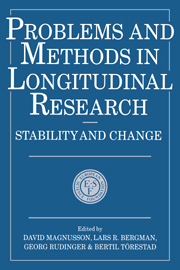Book contents
- Frontmatter
- Contents
- Contributors to this volume
- Foreword
- Preface
- 1 Studying individual development: problems and methods
- 2 Modeling individual and average human growth data from childhood to adulthood
- 3 Intraindividual variability in older adults' depression scores: some implications for developmental theory and longitudinal research
- 4 Now you see it, now you don't – some considerations on multiple regression
- 5 Differential development of health in a life-span perspective
- 6 Assessing change in a cohort-longitudinal study with hierarchical data
- 7 Statistical and conceptual models of ‘turning points’ in developmental processes
- 8 Qualitative analyses of individual differences in intra- individual change: examples from cognitive development
- 9 Application of correspondence analysis to a longitudinal study of cognitive development
- 10 Event-history models in social mobility research
- 11 Behavioral genetic concepts in longitudinal analyses
- 12 Genetic and environmental factors in a developmental perspective
- 13 Structural equation models for studying intellectual development
- 14 Longitudinal studies for discrete data based on latent structure models
- 15 Stability and change in patterns of extrinsic adjustment problems
- Index
10 - Event-history models in social mobility research
Published online by Cambridge University Press: 27 April 2010
- Frontmatter
- Contents
- Contributors to this volume
- Foreword
- Preface
- 1 Studying individual development: problems and methods
- 2 Modeling individual and average human growth data from childhood to adulthood
- 3 Intraindividual variability in older adults' depression scores: some implications for developmental theory and longitudinal research
- 4 Now you see it, now you don't – some considerations on multiple regression
- 5 Differential development of health in a life-span perspective
- 6 Assessing change in a cohort-longitudinal study with hierarchical data
- 7 Statistical and conceptual models of ‘turning points’ in developmental processes
- 8 Qualitative analyses of individual differences in intra- individual change: examples from cognitive development
- 9 Application of correspondence analysis to a longitudinal study of cognitive development
- 10 Event-history models in social mobility research
- 11 Behavioral genetic concepts in longitudinal analyses
- 12 Genetic and environmental factors in a developmental perspective
- 13 Structural equation models for studying intellectual development
- 14 Longitudinal studies for discrete data based on latent structure models
- 15 Stability and change in patterns of extrinsic adjustment problems
- Index
Summary
INTRODUCTION
The analysis of social mobility is probably the field of sociology that has been most affected by methodological and theoretical developments in the period since the 1950s (see, e.g., Sørensen, 1986). In classical mobility studies Rogoff (1953), Glass (1954), Svalastoga (1959), and Carlsson (1958) studied social inequality on the basis of mobility tables. These tables were obtained from cross-sectional samples of men who were asked about their current position and about their father's position when they grew up. However, as respondents had different ages at the time of the interview and therefore had different historical experiences, these efforts did not provide very interpretable results (Sørensen, 1986).
Mobility tables were sometimes disaggregated by birth cohorts (Featherman & Hauser, 1978; Goldthorpe, 1980), but this does not alleviate the problem because careers take place in the labor force. This means the relevant period is the amount of time spent in the labor force and not the age of the people (Blossfeld, 1986). Members of the same birth cohort are at different career stages because they spent different times in the educational system. Thus, positions reflected by mobility tables of birth cohorts are observations of locations of people at different stages in their career (Sørensen, 1986).
The typical mobility table not only ignores differences in the historical location of cohorts and the amount of labor force experience of people, but also neglects the fact that job mobility is strongly influenced by education and other background variables of the individual.
- Type
- Chapter
- Information
- Problems and Methods in Longitudinal ResearchStability and Change, pp. 212 - 235Publisher: Cambridge University PressPrint publication year: 1991
- 3
- Cited by



